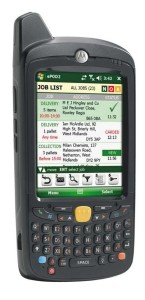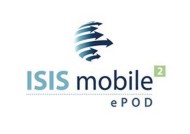 M-Netics, the mobile technology solutions expert, has been in existence less than a decade, but in that time has made its reputation as the developer of pioneering and leading edge software such as the IM2 Enterprise Mobility Suite, ISIS Retail products, and Quantum products.
M-Netics, the mobile technology solutions expert, has been in existence less than a decade, but in that time has made its reputation as the developer of pioneering and leading edge software such as the IM2 Enterprise Mobility Suite, ISIS Retail products, and Quantum products.
Headquartered in Chippenham, Wiltshire, M-Netics now has over 15,000 users running its applications. As well as IM2, ISIS Meteor and Quantum, M-Netics supplies complete end-to-end solutions covering all aspects of mobile hardware requirements. M-Netics’ solutions cover retail – both in-store and back office, supply chain, mobile worker and proof of delivery requirements, and their customers include leading logistics providers, manufacturers, retailers and field service organisations. M-Netics has close partnerships with leading mobile technology companies including Motorola Solutions, Zebra Technologies, IBM and ALK.
M-Netics has been making headlines in recent months with the launch of the IM2 ePOD next generation proof of delivery (ePOD) solution, which is set to drive efficiency gains, cut maintenance costs and improve customer service in logistics operations.
M-Netics’ Managing Director John Coon spoke to Warehouse & Logistics News.
Warehouse & Logistics News – First of all, John, as MD of M-Netics, what does your role involve from day to day?
My role takes in all parts of the business, from direct contact with customers to overseeing operations, monitoring service levels, working with the Financial Director and making sure we hit targets.
WLN – As MD, do you get personally involved either in new technology development or working with customers to develop tailored solutions?
 Yes, I do – while we produce standard software for retail and logistics, as a management team we have a major interest in ensuring our standard products can be tailored to individual customers’ requirements.
Yes, I do – while we produce standard software for retail and logistics, as a management team we have a major interest in ensuring our standard products can be tailored to individual customers’ requirements.
WLN – Who else is on the senior management team besides you?
There are four others – Simon Harrison, the Technical Director, Ben Waterworth, Financial Director, Stephen Godman, Sales Director, and Tim Hamilton-Davies, the founder.
WLN – When was M-Netics founded?
Tim Hamilton-Davies founded M-Netics in 2004. It grew out of a traditional mobile technology reseller, which acquired Simon Harrison’s company 5D, and then the two businesses came together as M-Netics.
WLN – Who owns M-Netics now?
Tim is the majority shareholder, and the other shareholders are the management team as mentioned, plus three other individuals. We are owner-operated, which is an important point of difference in our particular business sector as we can be more flexible and agile for our customers.
WLN – How big is M-Netics now turnover and personnel?
We turn over £12m and employ between 30 and 40 people, depending on our software development commitments.
WLN – Do you operate in any other countries?
We’re predominantly UK based and have no overseas offices, but have moved into other countries through the service requirements of our major customers such as New Look, Debenhams and G4S.
WLN – The mobile solutions market is quite crowded, with a large number of vendors offering a myriad of technologies. What sets M-Netics apart?
From the outset we have focused on mobile solutions for the retail and logistics sectors and targeted the supply chain. We consider our company a Mobile Solutions specialist. We offer high quality and high performance, practical software, and through strong engagement with our customers deliver solutions that meet their needs year after year.
WLN – What is the M-Netics proposition for the warehousing and logistics industry?
We offer a combination of industry understanding through our detailed research, and innovative technology, with our supply chain, proof of delivery and mobile worker solutions. We join up the different parts of the supply chain with solutions for use in store, in transportation and in the warehouse.
WLN – How do your partnerships work with Motorola Solutions, Zebra Technologies, IBM and ALK?
 These companies do more than just supply devices for our software. Motorola and Zebra are our two major partners: we’re experts in their technology, and we develop our software for use on their platforms and sell with them in a close relationship. ALK Technologies supply CoPilot Navigation software which we integrate into our IM2 ePOD solution. We also partner with IBM in some key accounts.
These companies do more than just supply devices for our software. Motorola and Zebra are our two major partners: we’re experts in their technology, and we develop our software for use on their platforms and sell with them in a close relationship. ALK Technologies supply CoPilot Navigation software which we integrate into our IM2 ePOD solution. We also partner with IBM in some key accounts.
WLN – How is M-netics structured to service the needs of warehousing and logistics customers? Do you sell direct, or through distributors?
We sell direct and have strong relationships with our customers. Our teams engage with all parts of our customers organisations to manage not just the implementation but also the continued support of the solution once live. We have in-house expertise in deploying wireless networks, and we provide design and consultancy services in this area.
WLN – We’ve heard a lot about your IM2 ePOD next generation solution. What does it do, exactly?
M-Netics’ IM2 ePOD is a modularised, flexible task-based workflow system, which integrates proof of delivery with fleet management, CRM and communications systems. Using advanced GPS tracking, this is a next generation solution that enables logistics managers to track job progress to improve customer service and boost security, while streamlining post-delivery processes such as invoicing. According to recent research, insufficient or incorrect technology is the biggest barrier to savings in the cost of deliveries. IM2 ePOD helps improve customer service, enhance efficiencies and reduce the operational costs for a courier business or fulfilment department.
WLN – How does IM2 ePOD work?
By integrating the latest technology, IM2 ePOD provides real-time visibility of assets and drivers to both the business and the customer for unrivalled customer service and process efficiency. It integrates proof of delivery with fleet management, CRM and communications systems, and enables logistics managers to track job progress to improve customer service.
WLN – How much room is there at present for improvement in logistics operations?
In our view, plenty! We commissioned independent research among IT decision makers in 100 UK logistics businesses with 100 or more employees. Over half – 54% – believed better integration of systems would deliver the greatest improvements to efficiency, and 43% believed the biggest barrier to achieving such savings was out of date technology. Change management concerns came second (24%), with a lack of timely information close behind in third place (20%.) There’s a lot of talk in British industry about a skills shortage, but surprisingly our respondents didn’t see a lack of skills as much of an issue, with just 13% reporting it as the biggest hurdle.
WLN – What level of possible cost savings are we talking about?
Based on our sample, delivery typically accounts for 17% of logistics costs. 19% said it took up over a quarter of their entire logistics budget. Respondents believed they could save – again on average – 13% of their logistics costs through better, more efficient delivery processes. For even a medium sized business, these savings could run into hundreds of thousands of pounds in the first year.
WLN – Where does technology come in?
 If current technology is the greatest barrier to logistics operations realising these savings, then next generation proof of delivery like our IM2 ePOD is all about overcoming that obstacle. Improving fulfilment with tools such as GPS, and then integrating and automating delivery into other business processes such as invoicing or after-sales, leads to a smarter, more efficient and cost-effective logistics operation, making the last leg of delivery operations more efficient, more cost-effective, greener and better for the customer.
If current technology is the greatest barrier to logistics operations realising these savings, then next generation proof of delivery like our IM2 ePOD is all about overcoming that obstacle. Improving fulfilment with tools such as GPS, and then integrating and automating delivery into other business processes such as invoicing or after-sales, leads to a smarter, more efficient and cost-effective logistics operation, making the last leg of delivery operations more efficient, more cost-effective, greener and better for the customer.
WLN – How much training does the delivery driver need to get the best results from this equipment? Is it easy to use?
We design our software to be obvious to use. Many users may be part-time employees and need to be able to use mobile technology easily, without much training. The configuration of the system guides the user through the process and tasks required to complete the job successfully.
WLN – What comes ‘in the box’ with IM2 ePOD?
It’s down to the customer. It isn’t supplied shrink-wrapped, and we provide the required configuration to meet the customer’s requirement.
WLN – How does IM2 fit into logistics operations’ existing systems?
IM2 delivers seamless XML integration into booking, planning and optimisation systems.
WLN – How long does IM2 ePOD take to repay the investment?
IM2 ePOD delivers instant business benefits and, depending on the specific installation, can have an ROI of within two years.
WLN – What level of orders have you had so far for IM2?
We deployed our first system in January 2011 to DHL Same Day and the second one in Q2 to John Bowler Eggs. We also have pilot systems in automotive distribution and with a large pharmaceutical distributor. We’re currently bidding for six or seven tenders, including a couple in Ireland and Benelux.
WLN – How can a logistics operator reading this work out if they could benefit from IM2?
How much an operator stands to benefit depends on their individual logistics operations. The general benefits are more efficient processes, rich management metrics, improved delivery of service and strong historical statistics. Different control level modules can also be added, for example our system lets John Bowler scan, sort and categorise the eggs they collect from their farms.
WLN – What solutions do you offer for the supply chain?
 M-Netics deploys applications across the complete supply chain, from real time warehouse management solutions and depot scanning software, through to delivery and collection systems. Speed, accuracy and visibility are vital components of supply chain solutions, and our applications allow our customers to manage the handling and routing of their goods quickly and easily. Exceptions and problems are reported in real time, and managers and supervisors can view the status of their operations through built-in dashboards. Our solutions support the latest technologies used in the modern warehouse or depot. From mobile, wearable handheld terminals to voice picking, the full range of new solutions can be brought to bear, with all the communications managed by the M-Netics applications to provide a practical, quick, intuitive and robust window onto your supply chain operation.
M-Netics deploys applications across the complete supply chain, from real time warehouse management solutions and depot scanning software, through to delivery and collection systems. Speed, accuracy and visibility are vital components of supply chain solutions, and our applications allow our customers to manage the handling and routing of their goods quickly and easily. Exceptions and problems are reported in real time, and managers and supervisors can view the status of their operations through built-in dashboards. Our solutions support the latest technologies used in the modern warehouse or depot. From mobile, wearable handheld terminals to voice picking, the full range of new solutions can be brought to bear, with all the communications managed by the M-Netics applications to provide a practical, quick, intuitive and robust window onto your supply chain operation.
WLN – Do you also carry out network installation and maintenance?
Yes, we do. M-Netics has a proven track record in the successful design and implementation of Motorola and Cisco wireless networks. From standalone distribution centres to multiple retail outlet requirements, we have experience of providing centrally switched or locally managed wireless networks to organisations with hundreds of locations. We provide a complete solution, from wireless network design, including sizing and surveys through to deployment, configuration, security, ongoing support, monitoring and management. In addition we provide a comprehensive consultancy service covering network design and performance assessment, servicing and upgrades across both wireless data and voice networks.
WLN – Who are your clients in the warehouse and logistics sector?
Our clients include DHL Supply Chain, DHL Same Day and Shoe Zone. For DHL Supply Chain we design and deploy wireless networks, and provide mobile technology and depot scanning software. For DHL Same Day, we provide their ePOD system We supplied Shoe Zone with the WMS for their distribution operations in Leicester, which picks over 750,000 pairs of shoes every week.
Fashion retailing is a particular niche we’ve developed which has come to the fore in recent years, working for such clients as River Island, New Look, Debenhams and Peacocks. The experience gained with these key clients and our understanding of the requirements for mobile technology for retail, has formed a core set of functionality that we are now integrating with our new IM2 platform. We market this solution as IM2 Retail.
WLN – Do you produce case studies?
Yes – see facing page.
WLN – How quickly can a system be up and running?
 If it’s a standard solution, it could take eight weeks from pilot to rollout. A complex interface with the client’s back-end could add weeks or months.
If it’s a standard solution, it could take eight weeks from pilot to rollout. A complex interface with the client’s back-end could add weeks or months.
WLN – Do you provide full training?
Yes, we do. For pilot schemes we conduct the training directly: for rollouts and larger organisations we train the client trainers.
WLN – How configurable are your solutions as operations change?
As I mentioned before, we don’t provide shrink-wrapped systems. They are modular and provide the core functionality required. Additionally, we can put in application modules for specific customer tasks or processes. For different job scenarios we can pull in process questionnaires and configurations and add parameters for metrics and management information. That said, we tend to find most customers have similar needs, so the bulk of the functionality is already there in the core modules. As a business our aim is to provide a standard package with rich functionality.
WLN – What service and support do you offer?
We deal with many major Tier 1 customers who have their own in house support desks, but for others we provide a full range of services, from Tier 2 and 3 support helpdesks to engineers on-call 24x7x365. Our help desk provides services from basic triage – understanding what the problem is – and remote diagnostics, to software support from the specific engineers who wrote or tested the application. We can provide a complete support package, covering network infrastructure, Hand Held Terminals, printers and software.
WLN – What effect have the recent tough economic conditions had on demand for your solutions?
The recent conditions have led people to look at doing more with our software, so the opportunities for software are very good. However we’ve seen some dampening in demand for new hardware, with people sweating their existing assets.
WLN – Finally, where do you see M-Netics going from here?
IM2 has already proven invaluable to our customers, and we are confident that the market is now ready for this next generation POD technology. We see the IM2 core software platform being deployed both in the UK and more widely overseas through partnerships. We will also continue to invest in functionality, including integrated payment transactions, further development of our tracking modules as well as extensions to the Web interfaces and management information tools in IM2, offering more all round capability for a lower cost. In addition we will be extending our IM2 solution into the general field service market.
We want to develop M-Netics through software-led growth with the IM2 Solution range in particular, which will secure more clients and build long standing relationships, and enhance our presence and position in the market.
M-Netics
Tel: 01249 554 150




Comments are closed.